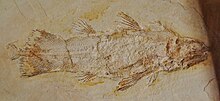Coccoderma
| Coccoderma Temporal range: | |
|---|---|

| |
| Specimen of C. suevicum | |
| Scientific classification | |
| Domain: | Eukaryota |
| Kingdom: | Animalia |
| Phylum: | Chordata |
| Clade: | Sarcopterygii |
| Class: | Actinistia |
| Family: | †Laugiidae |
| Genus: | †Coccoderma Quenstdedt, 1858 |
| Type species | |
| †Coccoderma suevicum Quenstdedt, 1858 | |
| Species | |
|
See text | |
| Synonyms | |
| |
Coccoderma is an extinct genus of prehistoric marine coelacanth which lived during the Late Jurassic period.[1] Fossils have been found in Germany and France.[2] It was small in size, about 27.5 cm. They had very long and sharp teeth.
It was one of the earliest coelacanths to be properly studied by science.[3] It lived far later than other members of its family (Laugiidae), which otherwise only existed during the Early Triassic, thus leaving an exceptional ghost lineage of over 100 million years. It was the last surviving member of the non-latimerioid coelacanths (e.g. coelacanths outside of Latimeriidae and Mawsoniidae).[4]
Species
- †C. bavaricum Reis, 1888 - Tithonian of Germany (Solnhofen Limestone)
- †C. gigas Reis, 1888 - Tithonian of Germany (Solhofen Limestone)
- †C. suevicum Quenstdedt, 1858 - Kimmeridgian (Nusplingen Limestone) and Tithonian (Solnhofen Limestone) of Germany (=Coelacanthus harlemensis Winkler, 1874, Coccoderma nudum Reis, 1888)[5]

An indeterminate species is known from the Tithonian-aged Canjuers Lagerstätte of France, which was previously thought to be from the earliest Cretaceous (Berriasian).[6][7][3] The species C. nudum likely represents an immature C. suevicum. The species C. bavaricum and C. gigas may not belong to this genus.[5][3] The species C. substriolatum from England has been reclassified as a mawsoniid, and tentatively to Trachymetopon.[8]
References
- ^ "PBDB Taxon". Paleobiology Database. Retrieved 2024-05-21.
- ^ Wendruff, Andrew J.; Wilson, Mark V.H. (2013). Sues, Hans (ed.). "New Early Triassic coelacanth in the family Laugiidae (Sarcopterygii: Actinistia) from the Sulphur Mountain Formation near Wapiti Lake, British Columbia, Canada". Canadian Journal of Earth Sciences. 50 (9): 904–910. doi:10.1139/cjes-2013-0010. ISSN 0008-4077.
- ^ a b c Silva, Raphael Miguel da (2016). "Biogeografia histórica de Celacantos (Sarcopterygii: Actinistia)" (PDF). bdtd.ibict.br. Retrieved 2024-05-21.
- ^ Toriño, Pablo; Soto, Matías; Perea, Daniel (2021-12-02). "A comprehensive phylogenetic analysis of coelacanth fishes (Sarcopterygii, Actinistia) with comments on the composition of the Mawsoniidae and Latimeriidae: evaluating old and new methodological challenges and constraints". Historical Biology. 33 (12): 3423–3443. doi:10.1080/08912963.2020.1867982. ISSN 0891-2963.
- ^ a b Lambers, Paul H. (1991-06-01). "The identity of the type specimen ofCoelacanthus harlemensis Winkler (Pisces, Actinistia) from the lithographic limestone of Solnhofen (Tithonian), Bavaria". Paläontologische Zeitschrift. 65 (1): 173–189. doi:10.1007/BF02985782.
- ^ Peyer, Karin; Charbonnier, Sylvain; Allain, Ronan; Läng, Émilie; Vacant, Renaud (2014-07-01). "A new look at the Late Jurassic Canjuers conservation Lagerstätte (Tithonian, Var, France)". Comptes Rendus Palevol. Lagerstätten français et fossiles à conservation exceptionnelle. 13 (5): 403–420. doi:10.1016/j.crpv.2014.01.007. ISSN 1631-0683.
- ^ Cloutier, Richard; Forey, Peter L. (1991), Musick, John A.; Bruton, Michael N.; Balon, Eugene K. (eds.), "Diversity of Extinct and Living Actinistian Fishes (Sarcopterygii)", The biology of Latimeria chalumnae and evolution of coelacanths, Dordrecht: Springer Netherlands, pp. 59–74, doi:10.1007/978-94-011-3194-0_4, ISBN 978-94-011-3194-0, retrieved 2024-05-21
- ^ Cavin, Lionel; Piuz, André; Ferrante, Christophe; Guinot, Guillaume (2021-06-03). "Giant Mesozoic coelacanths (Osteichthyes, Actinistia) reveal high body size disparity decoupled from taxic diversity". Scientific Reports. 11 (1): 11812. doi:10.1038/s41598-021-90962-5. ISSN 2045-2322. PMC 8175595.





